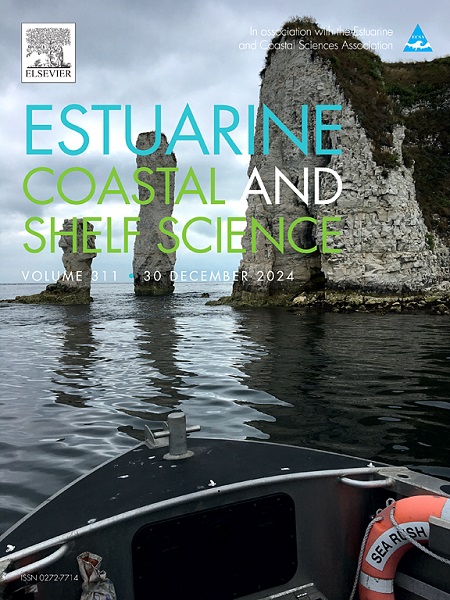菲律宾城市和农村沙滩的中微塑料积累和生态风险
IF 2.6
3区 地球科学
Q1 MARINE & FRESHWATER BIOLOGY
引用次数: 0
摘要
了解中塑料的命运对于推断微塑料污染水平至关重要,因为随着时间的推移,它们的降解对微塑料的积累起着重要作用。然而,菲律宾的海滩因其美丽的风景和湛蓝的海水而获得国际认可,但对其的研究却很少。我们评估了中微塑料(5-25毫米)和大微塑料(1-5毫米)在菲律宾城市和农村海滩的积累及其生态风险。在30个地点共鉴定出513个中微塑料和180个大微塑料,平均浓度分别为45.5±24.3个和16.1±0.190个/m2。采用ATR-FTIR分析对塑料颗粒进行了确证。预期中位和LMP丰度显著较高(p <;0.05),表明人为污染驱动因素。占主导地位的中塑料主要是白色(34.8%),薄膜状(38%),尺寸为5-10毫米(35.1%),聚丙烯(37.8%)是最普遍的聚合物。同样,LMP主要为白色(68%),泡沫状(66.3%),尺寸为4.0-4.9 mm(34.8%),聚苯乙烯(66.3%)为主要聚合物,显示工业,家庭和娱乐影响。此外,中观和LMP丰度之间的密切关系表明类似的污染源和潜在的塑料破碎。它们在细砂和粗砂中的比例分布进一步表明了相似的堆积模式。总体而言,城市海滩是污染热点,强调需要有针对性的干预措施,以减轻塑料污染对菲律宾海滩和海洋环境的影响。本文章由计算机程序翻译,如有差异,请以英文原文为准。

Meso- and microplastics accumulation and ecological risks in Philippine urban and rural sandy beaches
Understanding the fate of mesoplastics is crucial for inferring microplastic pollution levels, as their degradation over time contributes significantly to microplastic accumulation. However, Philippine beaches, which gained international recognition for their beautiful landscape and crystal-blue waters, are poorly studied. We assessed meso- (5–25 mm) and large-microplastic (1–5 mm) accumulation in urban and rural Philippine beaches and their ecological risks. A total of 513 meso- and 180 large-microplastics (LMP) were identified across 30 sites, with mean concentrations of 45.5 ± 24.3 items/m2 and 16.1 ± 0.190 items/m2, respectively. The plastic particles were confirmed using ATR-FTIR analysis. Expectedly, meso- and LMP abundances were significantly higher (p < 0.05) in urban than rural beaches, indicating anthropogenic pollution drivers. Dominant mesoplastics were primarily white in color (34.8 %), film-shaped (38 %), and measured 5–10 mm in size (35.1 %), with polypropylene (37.8 %) as the most prevalent polymer. Similarly, LMP were mainly white in color (68 %), foam-shaped (66.3 %), and measured 4.0–4.9 mm (34.8 %), with polystyrene (66.3 %) as the dominant polymer, showing industrial, domestic, and recreational impacts. Additionally, a strong relationship between meso- and LMP abundance suggests similar contamination sources and potential plastic fragmentation. Their proportional distribution in fine and coarse sands further indicates similar accumulation patterns. Overall, urban beaches are pollution hotspots, emphasizing the need for targeted interventions to mitigate plastic pollution impacts on Philippine beaches and the marine environment.
求助全文
通过发布文献求助,成功后即可免费获取论文全文。
去求助
来源期刊
CiteScore
5.60
自引率
7.10%
发文量
374
审稿时长
9 months
期刊介绍:
Estuarine, Coastal and Shelf Science is an international multidisciplinary journal devoted to the analysis of saline water phenomena ranging from the outer edge of the continental shelf to the upper limits of the tidal zone. The journal provides a unique forum, unifying the multidisciplinary approaches to the study of the oceanography of estuaries, coastal zones, and continental shelf seas. It features original research papers, review papers and short communications treating such disciplines as zoology, botany, geology, sedimentology, physical oceanography.

 求助内容:
求助内容: 应助结果提醒方式:
应助结果提醒方式:


